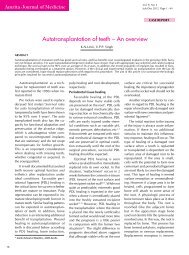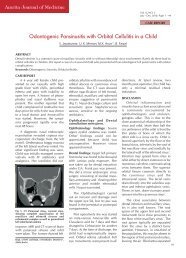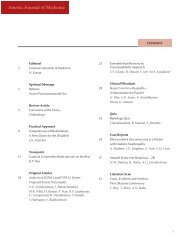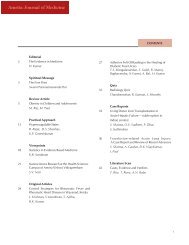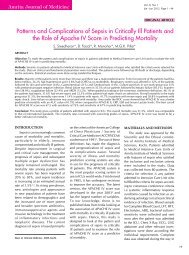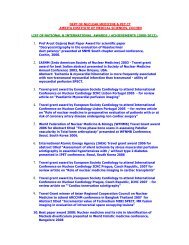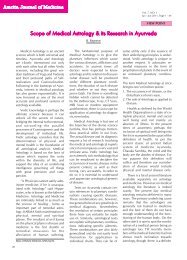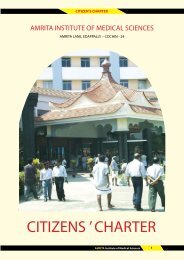Gaps in Noise (GIN) Test –Normative Data
Gaps in Noise (GIN) Test –Normative Data
Gaps in Noise (GIN) Test –Normative Data
Create successful ePaper yourself
Turn your PDF publications into a flip-book with our unique Google optimized e-Paper software.
Amrita Journal of Medic<strong>in</strong>e<br />
24<br />
ABSTRACT<br />
Temporal resolution is a sub categorization<br />
of temporal process<strong>in</strong>g.<br />
Temporal resolution refers to the ability<br />
of the auditory system to identify<br />
rapid changes <strong>in</strong> the envelope of a<br />
sound stimulus over time1 .<br />
The <strong>GIN</strong> test (Musiek 2003) is one<br />
such test to detect gap detection (GD)<br />
abilities. The Gap detection threshold<br />
(GDT) is def<strong>in</strong>ed as the shortest<br />
duration of gap with<strong>in</strong> a sound that<br />
a person can detect. This test has<br />
been found to be useful for assess<strong>in</strong>g<br />
temporal resolution2,3,4 .<br />
The gap detection studies have<br />
often been applied to patients with<br />
cortical lesions2 . Mu-siek et al (2005) 5<br />
have <strong>in</strong>cluded few bra<strong>in</strong>stem pathology<br />
patients (n=9) <strong>in</strong> their study and<br />
stressed the significance of adm<strong>in</strong>ister<strong>in</strong>g<br />
gap detection tests on more<br />
number of such patients. The <strong>GIN</strong> test<br />
is thus a valuable tool <strong>in</strong> identify<strong>in</strong>g<br />
temporal resolution deficits <strong>in</strong> cortical<br />
as well bra<strong>in</strong>stem lesions.<br />
* dept. of Speech pathology and Audiology,<br />
AiMS, Kochi.<br />
** dept. of Speech pathology and Audiology,<br />
niMHAnS, bangalore<br />
***dept. of Epidemiology, niMHAnS, bangalore<br />
<strong>Gaps</strong> <strong>in</strong> <strong>Noise</strong> (<strong>GIN</strong>) <strong>Test</strong> <strong>–Normative</strong> <strong>Data</strong><br />
G. Prem*, N.S. Shankar**, N. Girish***<br />
<strong>in</strong>troduction: The detection of gaps <strong>in</strong> noise is one of the temporal resolution abilities of the auditory system. The detection abilities us<strong>in</strong>g<br />
the <strong>Gaps</strong> In <strong>Noise</strong> (<strong>GIN</strong>) test is of great utility <strong>in</strong> assess<strong>in</strong>g patients with cortical and bra<strong>in</strong>stem lesions. Establish<strong>in</strong>g a normative database<br />
<strong>in</strong> Indian context on this test is of utmost importance for identify<strong>in</strong>g the pathological group.<br />
Aim: To establish a normative database for <strong>GIN</strong> test <strong>in</strong> Indian population and to ascerta<strong>in</strong> if any ear, gender and age group differences exist.<br />
Methodology: The <strong>GIN</strong> test was adm<strong>in</strong>istered on 100 normal hear<strong>in</strong>g subjects rang<strong>in</strong>g <strong>in</strong> age from 17-60 years (52 males and 48 females).<br />
Two <strong>in</strong>dices were used <strong>in</strong> our study-approximate threshold measurement or gap detection threshold (GDT) and total percentage score<br />
(TPS). The subjects were grouped <strong>in</strong>to two group’s viz., Group I: 17-40 years and Group II: 41-55 years.<br />
Results: Mean and standard deviation (SD) for both GDT and total percentage score were estimated: right ear: 5.82 msec (1.27) and left<br />
ear: 5.84 msec (1.11). The mean TPS <strong>in</strong> our study was right ear: 62.99% (8.48) and left ear: 63.25% (7.78). The results were statistically<br />
treated to determ<strong>in</strong>e ear, gender and age group differences.<br />
discussion: No significant differences were observed <strong>in</strong> any of these variables for both GDT and total percentage score.<br />
Given the diagnostic significance<br />
of <strong>GIN</strong> test, establish<strong>in</strong>g a normative<br />
database is of paramount importance<br />
for accurate del<strong>in</strong>eation between<br />
normal and abnormal temporal resolution<br />
abilities <strong>in</strong> subjects. It is also<br />
of immense value to determ<strong>in</strong>e any<br />
ear, gender and age group differences<br />
<strong>in</strong> normal hear<strong>in</strong>g subjects before<br />
adm<strong>in</strong>ister<strong>in</strong>g and <strong>in</strong>terpret<strong>in</strong>g the<br />
test results on cl<strong>in</strong>ical group. These<br />
f<strong>in</strong>d<strong>in</strong>gs are of utmost importance<br />
and can be considered as a gold<br />
standard to which the test results<br />
adm<strong>in</strong>istered on patient population<br />
can be compared. In India such a<br />
data base is not available for cl<strong>in</strong>ical<br />
neuroaudiological application of the<br />
<strong>GIN</strong> test and hence the present study<br />
was undertaken.<br />
OBJECTIVES OF THE STUDY<br />
To establish a normative database<br />
for <strong>GIN</strong> test <strong>in</strong> Indian population and<br />
to ascerta<strong>in</strong> any ear (right and left),<br />
gender (male and female) and age<br />
group (young and middle age) differences<br />
on test performance <strong>in</strong> normal<br />
hear<strong>in</strong>g subjects.<br />
METHODOLOGY<br />
One hundred subjects constituted<br />
the study group. The age of the<br />
Vol. 8, No: 1<br />
Jan - Jun 2012. Page 1 - 44<br />
Conclusion: The database developed can be of great utility <strong>in</strong> assess<strong>in</strong>g temporal resolution skills us<strong>in</strong>g <strong>GIN</strong> test <strong>in</strong> Indian context.<br />
subjects ranged from 17-60 years<br />
(52 males and 48 females). All<br />
subjects demonstrated pure tone<br />
thresholds of 20 dB HL or better<br />
for the octave frequencies of 250<br />
to 8000 Hz bilaterally. Subject<br />
<strong>in</strong>clusion criteria <strong>in</strong>cluded negative<br />
histories for audiologic, otologic and<br />
neurologic <strong>in</strong>volvement. The subjects<br />
were grouped <strong>in</strong>to two group’s viz.,<br />
Group I: 17-40 years and Group II:<br />
41-55 years.<br />
The <strong>GIN</strong> test was adm<strong>in</strong>istered<br />
and scored as per the set criteria<br />
(Musiek 2003). The stimulus was<br />
presented at 50 dB sensation level (SL)<br />
above puretone average (PTA) of 500,<br />
1000 and 2000 Hertz. The <strong>in</strong>dices<br />
used were Gap Detection Threshold<br />
(GDT) and Total Percentage Score<br />
(TPS).<br />
description of the test and<br />
scor<strong>in</strong>g<br />
The <strong>GIN</strong> is composed of 4 different<br />
lists designated as <strong>Test</strong> 1, <strong>Test</strong><br />
2, <strong>Test</strong> 3 and <strong>Test</strong> 4. The four lists<br />
conta<strong>in</strong> a series of up to 36 different<br />
6 second white noise segments. Each<br />
of the white noise segments conta<strong>in</strong><br />
anywhere from 0 to 3 gaps of silence.<br />
The duration of the silence gaps are
Amrita Journal of Medic<strong>in</strong>e<br />
either 2, 3, 4, 5, 6, 8, 10, 12, 15 or 20 msec with each<br />
silence gap duration occurr<strong>in</strong>g six times <strong>in</strong> each <strong>GIN</strong><br />
list. The order of the gap durations is randomized.<br />
Each <strong>GIN</strong> list conta<strong>in</strong>s a total of 60 gaps per list. A five<br />
second gap of silence separates each six second noise<br />
segment. Usually, one list is adm<strong>in</strong>istered <strong>in</strong> each ear.<br />
A practice list is provided at the beg<strong>in</strong>n<strong>in</strong>g of the test to<br />
ensure that the patient understands the task.<br />
While undergo<strong>in</strong>g the test, the subject needs to listen<br />
for any silence gap that may or may not occur with<strong>in</strong><br />
each noise burst. As soon as the gap is detected the<br />
subject has to respond by press<strong>in</strong>g the button.<br />
The GDT was calculated by consider<strong>in</strong>g the follow<strong>in</strong>g<br />
2 criteria:<br />
1) At least 4 out of 6 gaps are correctly identified<br />
2) Performance for longer gap durations is not<br />
worse than 4 out of 6 gaps correctly identified.<br />
The TPS was calculated by divid<strong>in</strong>g the total number<br />
Table 1: g<strong>in</strong> test performance classified based on ear and gender.<br />
Table 2: g<strong>in</strong> test performance classified based on age.<br />
<strong>Gaps</strong> <strong>in</strong> <strong>Noise</strong> (<strong>GIN</strong>) <strong>Test</strong> <strong>–Normative</strong> <strong>Data</strong><br />
of correct gap durations identified by the total number<br />
of gap durations presented (n=60) multiplied by 100.<br />
False positives were noted. When more than 2 false<br />
positives occurred per ear, it was counted as errors and<br />
sub-tracted from the number of gap durations identified<br />
(Musiek, 2003).<br />
RESULTS<br />
Mean and SD for both GDT and TPS were estimated<br />
(Table 1). Females had a mean GDT of 5.6 (1.086) msec<br />
<strong>in</strong> the right ear and 5.65 msec (.956) <strong>in</strong> the left ear.<br />
Males had a mean GDT of 6.02 msec (1.39) <strong>in</strong> the right<br />
ear and 6.02 msec (1.21) <strong>in</strong> the left ear. The mean total<br />
percentage score <strong>in</strong> females <strong>in</strong> the right ear was 64.92%<br />
(7.37) and 64.7% (8.03) <strong>in</strong> the left ear whereas; <strong>in</strong> males<br />
it was 61.21% (9.09) <strong>in</strong> the right ear and 61.92% (7.36)<br />
<strong>in</strong> the left ear. No statistical difference was observed<br />
between males and females for both GDT and TPS.<br />
Hence the data between the genders was clubbed to<br />
get a unified <strong>in</strong>dex for the right and left ears.<br />
Sex Right gdT R TPS left gdT left TPS<br />
Female Mean 5.6 64.92 5.65 64.70<br />
N 48 48 48 48.0<br />
Std Deviation 1.086 7.372 .956 8.0315<br />
Range 4 32 4 30<br />
Male Mean 6.02 61.21 6.02 61.919<br />
N 52 52 52 52<br />
Std Deviation 1.393 9.097 1.213 7.3664<br />
Range 7 42 6 45.6<br />
Total Mean 5.82 62.99 5.84 63.254<br />
N 100 100 100 100<br />
Std Deviation 1.266 8.479 1.108 7.780<br />
Range 7 43 6 45.6<br />
Coded Right GDT R TPS Left GDT Left TPS<br />
Age<br />
17-40 Mean 5.64 64.10 5.60 64.732<br />
Years N 70 70 70 70<br />
Std Deviation 1.274 8.719 1.095 8.3651<br />
Range 7 43 6.0 45.6<br />
41-55 Mean 6.23 60.38 6.4 5 9 . 8 0 6<br />
Years N 30 30 30 30<br />
Std Deviation 1.165 7.386 0.932 4.7505<br />
Range 3 24 3 21.7<br />
ANOVA revealed no statistically significant difference <strong>in</strong> <strong>GIN</strong> test performance between the groups for both GDT<br />
and total percentage score. There was also no statistically significant difference between right and left ear performances<br />
between groups for both <strong>in</strong>dices.<br />
25
Amrita Journal of Medic<strong>in</strong>e<br />
26<br />
In order to ascerta<strong>in</strong> the effect of age on <strong>GIN</strong> test<br />
performance (Table 2), the subjects were divided <strong>in</strong>to<br />
2 groups viz.,<br />
Group 1: 17-40 years of age.<br />
Group 2: 41-55 years of age.<br />
Group 1 subjects had a mean GDT of 5.64 m sec<br />
(SD=1.27) <strong>in</strong> the right ear and 5.6 m sec (SD=1.1) <strong>in</strong><br />
the left ear. Their mean total percentage score <strong>in</strong> the<br />
right ear was 64.1% (SD=8.72) and 64.73% (SD=8.37)<br />
<strong>in</strong> the left ear.<br />
Group 2 subjects had a mean GDT of 6.23 m sec<br />
(SD=1.17) <strong>in</strong> the right ear and 6.4 m sec (SD=. 932) <strong>in</strong><br />
the left ear. Their mean total percentage score <strong>in</strong> the right<br />
ear was 60.38% (SD=7.39) and 59.81% (SD=4.75) <strong>in</strong><br />
the left ear.<br />
DISCUSSION<br />
Auditory temporal process<strong>in</strong>g refers to the ability of<br />
the auditory system to identify temporal features of a<br />
sound. Common temporal features <strong>in</strong>clude sound envelope<br />
fluctuations (amplitude modulation, frequency<br />
modulation) or starts and stops <strong>in</strong> ongo<strong>in</strong>g sounds6 .<br />
The ma<strong>in</strong> types of auditory temporal process<strong>in</strong>g <strong>in</strong>clude<br />
phase lock<strong>in</strong>g, gap and duration cod<strong>in</strong>g (specialized<br />
neural responses to the onsets and offsets of sound<br />
energy), and cod<strong>in</strong>g of prosodic patterns (Pichora-Fullerpaper<br />
presentation, 2000).<br />
The temporal resolution is probably one of the basic<br />
<strong>in</strong>gredients for speech perception and its assessment<br />
may provide vital <strong>in</strong>formation about the neural <strong>in</strong>tegrity<br />
of the central auditory nervous system4,7 . It is a valuable<br />
tool <strong>in</strong> identify<strong>in</strong>g temporal resolution deficits <strong>in</strong> the<br />
lesions of the central auditory nervous system. To<br />
identify the pathological <strong>GIN</strong> behavior <strong>in</strong> patients, it<br />
becomes mandatory to have a normative database.<br />
In the present study the comparison of <strong>GIN</strong> test<br />
performance between males and females and between<br />
the subjects belong<strong>in</strong>g to the two groups (classified<br />
based on age) did not show any signifi-cant difference<br />
on both the <strong>in</strong>dices. Many <strong>in</strong>vestigators have demonstrated<br />
that older subjects may present with <strong>in</strong>creased<br />
GDTs <strong>in</strong> comparison to younger control subjects8,9,10,11,12 .<br />
Other studies have questioned this f<strong>in</strong>d<strong>in</strong>g13 . These<br />
discrepancies may be due to the <strong>in</strong>teraction between<br />
stimulus complexity and age. However, Musiek et al<br />
(2005) 5 op<strong>in</strong>es that s<strong>in</strong>ce the <strong>GIN</strong> test uses a simple<br />
stimulus (broadband noise) differences due to age factor<br />
is unlikely. His study reported no significant difference<br />
on <strong>GIN</strong> test performance of young and middle aged<br />
subjects. He et al (1999) 9 also share similar views while<br />
us<strong>in</strong>g broadband noise as stimuli. Lister et al (2002) 3<br />
stated that no significant difference exists between GDTs<br />
obta<strong>in</strong>ed for young and middle aged <strong>in</strong>dividuals. Our<br />
<strong>Gaps</strong> <strong>in</strong> <strong>Noise</strong> (<strong>GIN</strong>) <strong>Test</strong> <strong>–Normative</strong> <strong>Data</strong><br />
study also concurs with these studies. The GDT <strong>in</strong> our<br />
study (Right ear: 5.82 msec; SD=1.27 and Left ear: 5.84<br />
m sec; SD=1.11) is slightly higher than that of Musiek<br />
et al, (2005)5 (Right: 4.9 msec and Left: 4.8 msec) but<br />
lower than Keith’s (2000)14 study. The mean TPS <strong>in</strong> our<br />
study is lower (Right ear: 62.99%; SD=8.48 and Left<br />
ear: 63.25%; SD=7.78) than Musieks’ study5 , which<br />
reported 70% bilaterally.<br />
The GDTs obta<strong>in</strong>ed on subjects (patients as well<br />
as control group) seems to depend upon the extent<br />
of tra<strong>in</strong><strong>in</strong>g imparted to them prior to the actual test.<br />
This is supported by other researchers too5,15 . The<br />
performance on <strong>GIN</strong> test also depends on the ability<br />
of subjects to understand the <strong>in</strong>structions as well as to<br />
concentrate and respond accurately throughout the test<br />
duration. All these factors will <strong>in</strong> turn depend upon the<br />
subjects’ educational background, cognitive capacity<br />
and motivation. Thus, discrepancies observed <strong>in</strong> the<br />
different studies may be expla<strong>in</strong>ed. In a cl<strong>in</strong>ical situation<br />
it may be difficult to tra<strong>in</strong> the patients on this test for a<br />
longer period of time due to their health status, medical<br />
emergencies, cognitive level and short time available<br />
to the cl<strong>in</strong>icians. To offset these factors normative data<br />
on a sizable number with appropriate repre-sentation<br />
from all socio-economic and educational strata becomes<br />
necessary.<br />
CONCLUSION<br />
A database was developed for Normative <strong>GIN</strong> test by<br />
adm<strong>in</strong>ister<strong>in</strong>g the test on 100 normal hear<strong>in</strong>g subjects.<br />
Values were obta<strong>in</strong>ed for both the <strong>in</strong>dices of the test,<br />
GDT and total percentage score. Mean and standard<br />
deviation values for both the <strong>in</strong>dices were calculated.<br />
<strong>Test</strong> results revealed that there was no statistically<br />
significant difference among the performance of <strong>GIN</strong><br />
test between right and left ears, males or females and<br />
also young and middle aged subjects. This normative<br />
<strong>GIN</strong> <strong>Test</strong> database was developed on a large number of<br />
subjects (n=100) with different educational, cultural and<br />
cognitive capacities it can be utilized as a normative data<br />
<strong>in</strong> the cl<strong>in</strong>ical assessment of central auditory nervous<br />
system dysfunctions.<br />
REFERENCES:<br />
1. Plack C, & Viemeister N. Suppression and the dynamic range<br />
of hear<strong>in</strong>g. Journal of the Acoustical Society of America<br />
1993;93:976-982.<br />
2. Efron R, Yund E, Nichols D, et al. An ear asymmetry for gap<br />
detection follow<strong>in</strong>g anterior temporal lobectomy. Neuropsychologia<br />
1985;23:43-50.<br />
3. Lister J, Bes<strong>in</strong>g J, Koehnke J. Effects of age and frequency<br />
disparity on gap discrim<strong>in</strong>a-tion. Journal of the Acoustical<br />
Society of America 2002;111:2793-2800.
Amrita Journal of Medic<strong>in</strong>e<br />
4. Walton J, Fris<strong>in</strong>a R, Ison J, et al. Neural correlates of behavioral<br />
gap detection <strong>in</strong> the <strong>in</strong>fe-rior colliculus of the young CBA<br />
mouse. Journal of Comparative Physiology 1997;181:161-76.<br />
5. Musiek F, Sh<strong>in</strong>n J, Jirsa R, et al. The <strong>GIN</strong> (<strong>Gaps</strong>-In-<strong>Noise</strong>)<br />
test performance <strong>in</strong> subjects with confirmed central auditory<br />
nervous system <strong>in</strong>volvement. Ear Hear 2005;26:608-17.<br />
6. Fris<strong>in</strong>a R. Subcortical neural cod<strong>in</strong>g mechanisms for auditory<br />
temporal process<strong>in</strong>g. Hear Res 2001;158 (1-2):1-27.<br />
7. Gordon-Salant S, Fitzgibbons P. Temporal factors and speech<br />
recognition performance <strong>in</strong> young and elderly listeners.<br />
Journal of Speech and Hear<strong>in</strong>g Research 1993;36:1276-85.<br />
8. Bertoli S, Smurzynski J, Probst R. Temporal resolution<br />
<strong>in</strong> young and elderly subjects as measured by mismatch<br />
negativity and a psychoacoustic gap detection task. Cl<strong>in</strong>ical<br />
Neu-rophysiology 2002;113:396-406.<br />
9. He N, Horwitz A, Dubno J, et al. Psychometric functions<br />
for gap detection <strong>in</strong> noise measured from young and aged<br />
subjects. Journal of the Acoustical Society of America<br />
1999;106:966-78.<br />
10. Snell K. Age-related changes <strong>in</strong> temporal gap detection.<br />
Journal of the Acoustical Socie-ty of America 1997;101:<br />
2214-20.<br />
11. Snell K, Fris<strong>in</strong>a D. Relationships among age-related differences<br />
<strong>in</strong> gap detection and word recognition. Journal of the<br />
Acoustical Society of America 2000;107:1615-26.<br />
12. Strouse A, Ashmead D, Ohde R, et al. Temporal process<strong>in</strong>g<br />
<strong>in</strong> the ag<strong>in</strong>g auditory system. Journal of the Acoustical Society<br />
of America 1998;104:2385-99.<br />
13. Moore B, Peters R, Glasberg B. Detection of temporal gaps<br />
<strong>in</strong> s<strong>in</strong>usoids by elderly sub-jects with and without hear<strong>in</strong>g<br />
loss. Journal of the Acoustical Society of America 1992;92:<br />
1923-32.<br />
14. Keith R. Random Gap Detection <strong>Test</strong> (RGDT): Auditec of<br />
St. Louis 2000.<br />
15. Phillips D, Smith J. Correlations among with<strong>in</strong> channel and<br />
between-channel auditory gap detection thresholds <strong>in</strong> normal<br />
listeners. Perception 2004;33:371-8.<br />
27



